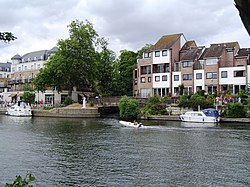River Colne, Hertfordshire



The Colne is a river which rises in Hertfordshire and flows for most of its course through that county, before becoming a boundary river, the river, or rather its original course, forming the boundary first between Hertfordshire and Middlesex and then between Buckinghamshire and Middlesex before entering the River Thames near Staines. At its latter end, the boundary is marked by a distributary, the Colne Brook.
The Colne splits off into several separate branches, some of which rejoin it, and it flows into the River Thames on the reach above Penton Hook Lock at Staines. It is a river much used: from Rickmansworth the river's course is marked almost continuously with abandoned chalk pits and with reservoirs. The Grand Union Canal also shares its valley and borrows its water, causing the river's couse to be diverted in many places.
Course of the river
The Colne rises near North Mymms in Hertfordshire, although the now dry river bed can be followed further back for about a mile and a quarter to the Water End Swallow holes).[1] It runs south west to Watford, flowing though the bottom of the town below the High Street, and on to Croxley Common Moor and Rickmansworth, where it waters the Aquadrome. West of Rickmansworth the Colne meets the Middlesex boundary and soon it and the Grand Union Canal have close, parallel courses to Uxbridge. Here its distributary the Frays River splits off which is joined by the River Pinn. The Colne Brook splits off at Uxbridge and at West Drayton the Frays River rejoins and the Wraysbury River and Duke of Northumberland's River break off.
The villages of Colney Heath near St Albans, Colney Street near Radlett, Colnbrook near Slough and London Colney in Hertfordshire all take their name from this river.
Man-made channels and lakes
In its lower reaches, the river supplies water to Longford River, a 12-mile artificial channel created in 1610 for King Charles I to supply water features in Bushy Park.[2]
The river underwent considerable change in the 1790s, when the Grand Junction Canal (which became part of the Grand Union Canal in 1929) was routed along the valley, and joined the river channel for part of its course. Construction began from Brentford, where it used the channel of the River Brent, and progressed northwards, with it reaching Uxbridge in November 1794. It continued along the river channel until its junction with the River Gade, which it ran parallel to, but did not take over the channel.[3] The Slough Arm was built much later, in 1882, and required three aqueducts near its junction with the Grand Junction main line, to cross the Fray's River, the River Colne and the Colne Brook.[4] There had been earlier proposals to link the river to London, including one in 1641 by Sir Edward Forde, for a navigable canal, the main purpose of which seems to have been the supply of clean water, and two in 1766, for canals from Marylebone to the river at Uxbridge and another from Marylebone to West Drayton.[5]
Between Croxley Green, where the River Gade joins the Colne, and West Drayton, below the Slough Arm, the river channels thread their way between many large lakes, some of which were once watercress beds, some chalk pits,[6] and some of which were the result of brickmaking, an industry which developed over several miles of the valley after 1800, when the Grand Junction Canal company advertised the presence of good brick earth, discovered during the construction of the canal.[5]
Tributaries and distributaries
These are listed from mouth (Thames) to source:
- Wraysbury River (branch West Drayton to Staines)
- River Ash (Staines to River Thames Sunbury on Thames)
- Colne Brook (Uxbridge Moor to River Thames Hythe End)
- Longford River (man made - Longford to River Thames Hampton Court)
- Duke of Northumberland River (man made West Drayton to River Thames Isleworth)
- Frays River (branch Watford to West Drayton)
- River Pinn (Harrow Weald to West Drayton)
- River Misbourne (Amersham to Uxbridge)
- Alder Bourne (Fulmer to Colne)
- River Chess (Chesham to Rickmansworth)
- River Gade
- River Ver (Dolittle Mill to Colne)
- Tykes Water (Aldenham Reservoir to Colne)
- Ellen Brook (Hatfield to Colne)
- Mimmshall Brook (Elstree to Colne)
- Catherine Bourne (Shenley to Mimmshall Brook)
- Potters Bar Brook (Potters Bar to Mimmshall Brook)
Books
- Hadfield, Charles (1970). The Canals of the East Midlands. David and Charles. ISBN 0-7153-4871-X.
- Nicholson (2006). Nicholson Guides Vol 1: Grand Union, Oxford and the South East. Harper Collins. ISBN 978-0-00-721109-8.
References
- ↑ http://www.brookmans.com/walks/walk3.shtml Brookmans Park walks]
- ↑ "Bushy Park". Royal Parks. http://www.royalparks.org.uk/parks/bushy_park/landscape_history.cfm. Retrieved 2011-09-03.
- ↑ Hadfield 1970, p. 111
- ↑ Nicholson 2006, pp. 38–39
- ↑ 5.0 5.1 Hadfield 1970, p. 113
- ↑ Nicholson 2006, pp. 42–45